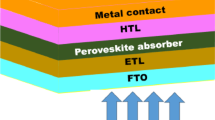Abstract
A heterojunction solar cell with two absorber layers has been simulated using SCAPS-1D software. To overcome the toxicity of lead in perovskite-based solar cells, a tin-based perovskite structure has been used along with copper zinc tin sulfide (CZTS). Considering two absorber layers, key parameters like thickness, defects, and interface defect densities have been optimized to obtain an enhanced efficiency. A detailed study of defect density and its variation with lifetime, diffusion length, and efficiency are described. The investigation reveals that minimum defect density results in maximum output. On optimizing various parameters, an enhanced result of open circuit voltage (Voc) 0.92 V, short circuit current density (Jsc) 42.74 mA/cm2, fill factor (FF) 78.32%, and efficiency (ɳ) 30.83% have been yielded. A comparative study with previous experimental and theoretical data has been carried out to validate the present study.





Similar content being viewed by others
References
Best Research-Cell Efficiency Chart. NREL, https://www.nrel.gov/pv/cell-efficiency.html.
N.K. Sinha, P. Roy, D.S. Ghosh, and A. Khare, Simulation and analysis of Schottky junction perovskite solar cells (SJPSCs). IOP Conf. Ser. Mater. Sci. Eng. 1120, 012017 (2021).
Q. Wu, C. Xue, Y. Li, P. Zhou, W. Liu, J. Zhu, S. Dai, C.F. Zhu, and S. Yang, Kesterite Cu2ZnSnS4 as a low cost inorganic hole transporting material for high efficiency perovskite solar cells. ACS Appl. Mater. Interfaces 7(51), 28466 (2015).
H.T. Ali, M. Jamil, K. Mahmood, M. Yusuf, S. Ikram, A. Ali, N. Amin, K. Javaid, M.Y. Ali, and M.R. Nawaz, A simulation study of perovskite based solar cells using CZTS as HTM with different electron transporting materials. J. Ovonic Res. 17(5), 437 (2021).
L. **ang, F. Gao, Y. Cao, D. Li, Q. Liu, H. Liu, and S. Li, Progress on the stability and encapsulation techniques of perovskite solar cells. Org. Electron. 106, 106515 (2022).
F. Liu, J. Zhu, J. Wei, Y. Li, M. Lv, S. Yang, B. Zhang, J. Yao, and S. Dai, Numerical simulation: toward the design of high-efficiency planar perovskite solar cells. Appl. Phys. Lett. 104, 253508 (2014).
A. Hima, A. Khechekhouche, I. Kemerchou, N. Lakhdar, B. Benhaoua, F. Rogti, I. Telli, and A. Saadoun, GPVDM simulation of layer thickness effect on power conversion efficiency of CH3NH3PbI3 based planar heterojunction solar cell. Int. J. Energ. 3(1), 37 (2018).
A. Hima, N. Lakhdar, B. Benhaoua, A. Saadoune, I. Kemerchou, and F. Rogti, An optimized perovskite solar cell designs for high conversion efficiency. Superlattices Microstruct. 129, 240 (2019).
J. Gong, Simulation of steady-state characteristics of heterojunction perovskite solar cells in wxAMPS. Opt. Int. J. Light Electron Opt. 232, 166382 (2021).
I. Mohanty, S. Mangal, and U.P. Singh, Performance optimization of lead free-MASnI3/CIGS heterojunction solar cell with 28.7% efficiency: a numerical approach. Opt. Mater. 122, 111812 (2021).
A.K. Singh, S. Srivastava, A. Mahapatra, J.K. Baral, and B. Pradhan, Performance optimization of lead free-MASnI3 based solar cell with 27% efficiency by numerical simulation. Opt. Mater. 117, 111193 (2021).
S.K. Mishra, S. Padhy, and U.P. Singh, Silver incorporated bilayer Kesterite solar cell for enhanced device performance: a numerical study. Sol. Energy 233, 1 (2022).
A. Shafi, L. Khan, S. Ullah, Md.Y. Shafi, A. Bouich, H. Ullah, and B. Mari, Novel compositional engineering for ~26% efficient CZTS-perovskite tandem solar cell. Opt. Int. J. Light Electron Opt. 253, 168568 (2022).
R. Tala-Ighil Zaïr, C. Oudjehani, and K. Tighilt, SCAPS simulation for perovskite solar cell. J. Sol. Energy Res. Updates 8, 21 (2021).
B. Mahapatra, R.V. Krishna, and P.K. Patel, Design and optimization of CuSCN/CH3NH3PbI3/TiO2 perovskite solar cell for efficient performance. Opt. Commun. 504, 127496 (2022).
S. Yasin, T. Al Zoubi, and M. Moustafa, Design and simulation of high efficiency lead-free heterostructure perovskite solar cell using SCAPS-1D. Opt. Int. J. Light Electron Opt. 229, 166258 (2021).
K. Tan, P. Lin, G. Wang, Y. Liu, Z. Xu, and Y. Linm, Controllable design of solid-state perovskite solar cells by SCAPS device simulation. Solid-State Electron. S0038–1101, 30142 (2016).
A.E. Benzetta, M. Abderrezek, and E. Djeghlal, Numerical study of CZTS/CZTSSe tandem thin film solar cell using SCAPS-1D. Opt. Int. J. Light Electron Opt. 242, 167320 (2021).
Y. Chen and H. Zhou, Defects chemistry in high-efficiency and stable perovskite solar cells. J. Appl. Phys. 128, 060903 (2020).
I.T. Bello, M.K. Awodele, O. Adedokun, O. Akinrinola, and A. Oladiran Awodugba, Modeling and simulation of CZTS-perovskite sandwiched tandem solar cell. Turk. J. Phys. 42, 321 (2018).
X. Li, X. Zhao, Y. Gu, X. Yin, H. Nan, M. Tai, H. Chen, and H. Shen, Lin, H, Solution-processed kesterite Cu2ZnSnS4 as efficient hole extraction layer for inverted perovskite solar cells. Chem. Lett. 47, 817 (2018).
I. Kabir and S.K.A. Mahmood, Comparative study on perovskite solar cells using inorganic transport layers. In IEEE Xplore (2019).
Acknowledgments
The authors would like to thank Marc Burgelman, ELSI, University of Gent, Belgium for providing the SCAPS simulation software (Version: SCAPS3307; 21 February, 2019).
Author information
Authors and Affiliations
Corresponding author
Ethics declarations
Conflict of interest
The authors declare that they have no known competing financial interests or personal relationships that could have appeared to influence the work reported in this paper.
Additional information
Publisher's Note
Springer Nature remains neutral with regard to jurisdictional claims in published maps and institutional affiliations.
Rights and permissions
Springer Nature or its licensor (e.g. a society or other partner) holds exclusive rights to this article under a publishing agreement with the author(s) or other rightsholder(s); author self-archiving of the accepted manuscript version of this article is solely governed by the terms of such publishing agreement and applicable law.
About this article
Cite this article
Mohanty, I., Mangal, S. & Singh, U.P. Defect Optimization of CZTS/MASnI3 Heterojunction Solar Cell Yielding 30.8% Efficiency. J. Electron. Mater. 52, 2587–2595 (2023). https://doi.org/10.1007/s11664-023-10221-3
Received:
Accepted:
Published:
Issue Date:
DOI: https://doi.org/10.1007/s11664-023-10221-3




